Paul Delaroche: Painting and Popular Spectacle by Patricia Smyth
Reviewed by Gülru ÇakmakGülru Çakmak
Associate Professor
University of Massachusetts Amherst
Email the author: gcakmak[at]umass.edu
Citation: Gülru Çakmak, book review of Paul Delaroche: Painting and Popular Spectacle by Patricia Smyth, Nineteenth-Century Art Worldwide 22, no. 2 (Autumn 2023), https://doi.org/10.29411/ncaw.2023.22.2.8.
This work is licensed under a Creative Commons Attribution-NonCommercial 4.0 International License  unless otherwise noted.
unless otherwise noted.
Your browser will either open the file, download it to a folder, or display a dialog with options.
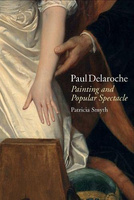
Patricia Smyth,
Paul Delaroche: Painting and Popular Spectacle.
Liverpool: Liverpool University Press, 2022.
264 pp.; 10 color and 51 b&w illus.; bibliography; index.
$143.00 (hardcover)
ISBN: 9781802070217
Patricia Smyth’s Paul Delaroche: Painting and Popular Spectacle focuses on a shift in nineteenth-century spectatorship practices that reached a turning point in the 1820s and 1830s. Against this background, the author examines the French history painter Paul Delaroche’s (1797–1856) pursuit of novel pictorial devices that facilitated the viewer’s engagement. The crux of Smyth’s argument is that Delaroche’s work in the 1830s responded to a contemporary demand for authenticity that manifested itself not only in the popular audience’s reception of painting and theater, but also in the everyday comportment of the self: the viewer’s experience of the sensation of authenticity shared the same origins as one’s perception of their social interlocutor’s genuineness. Smyth locates the foundational drive to all this in a particular characteristic of the modern sense of self, specifically, “a new conception of interiority in which authenticity was characterized as essentially hidden” (114). Even as the author traces the yearning for authenticity of the self to its eighteenth-century precedents, she points out that by the 1820s, the always-already paradoxical understanding of a hidden, authentic self, which could not be directly communicated but only obliquely intimated through instances of naïveté, awkwardness, or unconsciousness, had set the standard of truthfulness impossibly high: artists could no longer convey authenticity through clear and legible expression of emotions without being accused of unpersuasive theatricality. Smyth adroitly situates the inexorable modernity of Delaroche’s paintings such as Cromwell and Charles I (fig. 1) and The Execution of Lady Jane Grey (fig. 2) in this context, thereby elucidating some of the specificities of the artist’s pictorial choices.
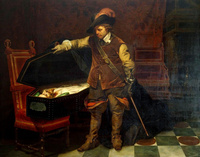
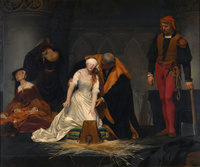
In making a case for Delaroche’s inventive response to demands for a new kind of painting as necessitated by new forms of spectatorship in the 1820s and 1830s, Smyth exclusively focuses on the genre of history painting. Chapter 2, entitled “Theatricality, Authenticity, and the Expression of Emotion,” argues that key pictorial choices—such as the blindfolded Lady Jane Grey’s awkwardness vis-à-vis the execution bloc and a seemingly expressionless Oliver Cromwell ambiguously looking down at the decapitated body of the former king—spoke to a newly-emergent public that assessed works of art according to their emotional authenticity, and the perceived genuineness of the figures depicted in them. Such pictorial decisions suggested that both Jane Grey and Cromwell had interior states of mind that were responding to the situation in which they found themselves. The genuineness of the inner lives of the protagonists subsequently prompted the viewers themselves to experience deep emotions.
In Smyth’s account, the case against theatricality in the fine arts—i.e., against inauthentic ways of addressing an audience—was based on expectations as to what constituted truthful comportment. Viewer demands had become increasingly extreme over time since the eighteenth century. One of the examples that the author provides of this emergent desire for an authentic inner experience comes from historical genre painting (le genre historique), Jean-Baptiste Vermay’s (1786–1833) Mary Queen of Scots Receiving Her Death Sentence exhibited at the Salon of 1814. Evading conventional vocabularies of mimicry and gestures reflective of inner states—such as Charles Le Brun’s (1619–90) deeply influential, widely circulated and copied têtes d’expressions—Vermay’s painting offers a single devastating clue of Mary’s psychological state as she is led away for execution: her right hand fleetingly grazing the prieu-dieu for support. While Smyth does not directly compare this painting to Delaroche’s Jane Grey, the implied link is well taken: by 1835, the injunction against legibility—in other words, the equation between clarity of expression and accusations of theatricality—had gone even further, and it is in this context that Delaroche’s blindfolded Jane Grey, in the process of leaning toward the chopping block, gawkily reaches out with her hands. Unlike Vermay’s Mary, the central role played by Delaroche’s Jane Grey’s elegant hands indicates neither moral strength nor stoicism in the face of imminent annihilation. Instead, the gesture communicates, in Smyth’s words, the soon-to-be-killed woman’s “abdication of conscious thought . . . leaving only those involuntary movements and reflex actions that are impossible to dissimulate” (101). While drawing on precedent—compare Jane Grey’s weeping maids in the left background to the crying woman in blue in Jacques-Louis David’s (1748–1825) The Lictors Bringing Brutus the Bodies of His Sons (fig. 3)—Delaroche’s Jane Grey’s popular success at the Salon of 1835, according to Smyth’s argument, stemmed from the way in which it radically severed the articulation of the protagonist’s psychology from a pre-established and conventional repertory of gestures that had come to be deemed rehearsed, and subsequently, inauthentic.
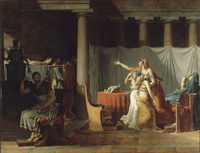
Scholarly precedents to Smyth’s analysis of Delaroche include such researchers as Stephen Bann and Beth Wright. Bann’s work, in particular, with its extensive and meticulous investigation of primary sources, has been groundbreaking. Acknowledging her own debt to recent scholars, Smyth is nevertheless careful in making the case that certain art historical meta-narratives pertaining to the trajectory of modernity in nineteenth-century European art have, nonetheless, been operational in numerous contemporary accounts of Delaroche’s work. Consider, for instance, the often-repeated myth regarding the transparency of the artist’s facture. The invisibility of facture marks on the surfaces of Delaroche’s canvases are often decoded by present-day art historians as a function of their “stylelessness.” His paintings have been portrayed, in Smyth’s words, as “a type of image that appears transparent in the sense of seeming to have no style at all” (207). If, say, Eugène Delacroix’s (1798–1863) tempestuous brushwork irrevocably foregrounds the artist’s embodied presence, Delaroche’s smooth surfaces ostensibly hide the artist’s presence according to many scholarly accounts. Taking issue with this a priori notion, Smyth is adamant that we not only take into account the subject matter of Delaroche’s paintings, but also his technique, the strategic pictorial choices that seemingly efface the painting’s status as an artifice.
In her bid to highlight the indelible modernity of Delaroche’s work and the ongoing relevance of his pictorial choices, Smyth draws on contemporary New Media Studies. More specifically, in order to explain the emergent aesthetic of authenticity in the nineteenth century, Smyth repurposes the terms “immediacy” and “immersive” following Jay David Bolter and Richard Grusin’s definitions.[1] According to Smyth, the nineteenth-century aesthetic of immediacy aimed to create for its public “the sensation that one was looking not at staging, but at a fragment of a larger reality” (11). In accounting for the growing demand for authenticity, she highlights the period’s perception of the historical past’s ineradicable distance from the present: “[t]he concept for immediacy as something promised but always, by definition, just out of reach is particularly relevant to the representation of history in a period of rupture: only when the past is irretrievably lost do we yearn to recapture it in all its material detail” (210). Her goal is to demonstrate that Gotthold Ephraim Lessing’s (1729–81) system underlies modernist accounts of the history of nineteenth-century art and renders them flawed. In contrast, she situates Delaroche’s work within a broader network of an emergent aesthetics shared by a variety of artistic media including theater: “an immersive strategy designed to erase the awareness of medium altogether” (9). Delaroche’s successful paintings shared the same characteristics with performances of the actress Marie Dorval (1798–1849). Both employed an artful artlessness of technique that was deliberately distanced from established conventions in order to communicate “the Real” to a public that sought to be emotionally moved. In both instances, qualities such as “incoherence and illegibility” (103) as well as ambiguity, strangeness, and triviality—unexpected transgressions of established conventions—were decoded as markers of authenticity by those viewers who were convinced by them (107).
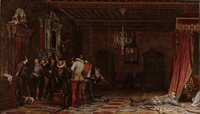
Chapter 3, “Narrative Strategy: The Assassination of the duc de Guise, Henri III et sa cour, and Early Nineteenth-Century Word-Image Debates,” offers a comparative analysis of the critical reception of Alexandre Dumas’s (1802–70) play Henri III et sa cour (Henry III and his Court), which premiered on February 10, 1829, at the Comédie-Française, and Delaroche’s The Assassination of the duc de Guise (fig. 4), shown at the Salon of 1835. Smyth provides a case study of the deficiencies of Lessing’s proposition that different artistic media occupy their own autonomous zones. The chapter examines the painting and the play as two experimental ways in which “the Real” was presented to the public. Both the play and the painting were criticized for “having strayed outside of their proper spheres” at the time of their presentation. Through careful reading of primary sources, Smyth convincingly demonstrates that the critics’ objections were not to the works’ presumed transgression of the boundaries of each medium, but to “a shared concern with eyewitness experience” (117). Both the play and the painting, as Smyth argues, used devices that were interpreted as real and unmediated experiences of the past, putting them on a par with the archaic genre of a historical chronical. In Smyth’s analysis, both the painting and the play are littered with markers of the indelible alterity of the past, signaling the sixteenth century’s radical difference from and distance to the present time. This quality of ambiguity, decoded as raw and unmediated experience, transgressed established conventions of tragedy and history painting in both cases, according to the author.
The book avidly makes the case not only for the modernity of Delaroche’s work, but also for the enduring influence of the artist’s pictorial strategies on subsequent art and visual culture in chapter 4, “Afterlives and Legacies: Delaroche’s Modernity.” Of help to Smyth in analyzing the painter’s pictorial inventions in general and use of the art of the past in particular is Bolter and Grusin’s concept of “remediation.” In the process of remediation, an image created in an older medium is re-presented in a new one, allowing the viewer to both simultaneously recognize the image and appreciate the new medium as a corrective to the limitations of the older form, with the overall process experienced as seemingly lifting “the veil of mediation altogether” (152). It is in this context that Smyth assesses Delaroche’s treatment of well-known historical figures as geared toward intensifying “the sensation of immediacy experienced by the viewer” (152). Therefore, when Delaroche presents Lady Jane Grey as weak and tangibly disoriented, he effectively goes against the grain of established textual and pictorial conventions that portrayed a stoic young woman with an impeccable strength of character. Presenting a corrective remediation at the psychological level, Delaroche’s painting adjusts the received type in response to the needs of the new audience that demanded to experience authenticity in its own terms as a prerequisite for a successful history painting.
Remediation happens on a visual level as well, as is vividly illustrated by Smyth’s discussion of The Assassination of the duc de Guise (see fig. 4). At the time of its Salon display, many critics saw the meticulously detailed bedroom in which the duke is assassinated as littered with superfluous historical minutiae that did not contribute to the story. It is here that Smyth demonstrates the full power of the artful artlessness of Delaroche’s remediation technique. The painting’s successful bid to facilitate an experience of authenticity hinges on nothing less than a full repossession of a wide array of compositional and pictorial elements from previous prints and paintings that depicted the same subject matter. In comparing Delaroche’s duc de Guise to sixteenth-century engravings such as Frans Hogenberg’s (1535–90) prints, Smyth traces a similar proliferation of minute details, contending that Delaroche’s painting deliberately emulates the itemizing language of the print while replenishing its archaic visual conventions, making thus a discursive bid for authenticity in order to persuade the contemporary viewer of the painting’s superior ability to access a deeper historical truth. This, as Smyth argues, presented the Salon-going public with a novel kind of emotional experience, beckoning the modernity of Delaroche’s project.
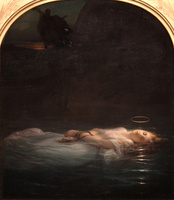
One question that Smyth’s account inspires for a future investigation pertains to the specificity of the medium of oil painting in the age of remediation. Ontologically, what did oil painting offer that could neither be replaced nor replicated by any other medium? Why did it endure in an age of an overabundance of innovative technologies of vision? A closer, deeper look at Delaroche’s facture, such as in the handling of the complex surface of A Young Christian Martyr (fig. 5), may provide us with new directions of exploration.
Notes
[1] Jay David Bolter and Richard Grusin, Remediation: Understanding New Media (Cambridge, MA: MIT Press, 1999).